Of course, there’s no reason not to have both so I’ll add my comments throughout in lovely Blue Cambria Italic 14 point. Enjoy…
It’s Friday already. A whole week of “new discoveries” has taken place and in some ways it feels like several lifetimes have also gone by. (That should read "incarnations. Think "cultural relativism.") I’m sitting out side our tent in Pushkar, India. It’s in the mid 90’s in the shade and pretty much unbearable in the sun. However it’s a dry heat… so I guess that makes it okay. (No, no it doesn’t) The flies are landing faster than I can swat them away…. Other than that, there really are not many bugs… although the ants are very scary looking – they have very long legs and move extremely fast. (Evolution would pretty much favor long legs and speed when you're dragging "Mr. Happy" through burning sand all day.)
We’ve been to the Pushkar festival 2009 a couple of times now. The people are all very friendly and of course there are the hawkers who either want you to pay them for taking their picture or they want to sell you something. Watch out if they say “Please, just 20 for this.” They don’t mean rupees. (They mean camels and small change is tricky to handle… I have a pocketful of Canadian sheep that no-one will accept.) It’s dusty, hot, noisy, claustrophobic and at the same time colorful and exotic.. the music is strangely hypnotic and the smells are a mix of ? & ?.
We stayed in a special tent village that is only put up for 2 weeks every year. Our tent had an attached bathroom with running water and a western toilet.. It was actually very comfortable.
While at the festival observing some of the various exhibits and shows, we were asked to take part in the turban wrapping contest. (Nothing like being in the right place at the right time. Also, I apparently resemble a Maharajah in some inexplicable manner. I hear this a lot here. At least it’s less annoying than hearing that I look like Celine Dionne’s creepy husband, which I get in Vegas…) I guess it’s only fair that the locals get a good laugh at our expense. The goal of the contest was for the women to tie the turban on the man and whomever was fastest won. Denny and I came in second. It probably would have been first, except that I forgot I needed to tie a ribbon around Dennis’s wrist. (We definitely would have been first. Plus we were a real crowd favorite. Staci started out the practice session by wrapping the material around my neck which the Indian women just loved. She finished the turban way ahead of the pack and had applied the dye to my forehead. All she had to do was tie the ceremonial knot doodad on my wrist and …. Well, no sense crying over spilled ghee. Still, we brought home the Silver for the USA and that’s nothing to sneeze at.) We were awarded a trophy that commemorated the achievement. The date on the trophy showed the year as 20009. There were many photographers there taking our picture. Denny and I were doing the American thing and smiling broadly. Then very sternly, one of the photographers motioned to me and said “No! Serious” so I stopped smiling (I guess the women are supposed to show honor to their husbands by taking everything a bit serious… at least that’s what we were told it’s supposed to be like during their wedding ceremonies. If they smile, then the groom's mother might feel that she’s being replaced.). While making our way back to the stands everyone was shaking Denny’s hand and congratulating him on his success. Walking several paces behind I couldn’t help but feel that it was a bit unfair that he was getting all the attention. After all, I was the one who masterfully tied the turban on top of his big pumpkin head! (It’s apparent that Staci doesn’t appreciate the work, concentration and planning involved in sitting perfectly still. Plus my big, pumpkin cranium required fewer turns than those of the sad microcephalics smiling and waving uncertainly from the loser’s circle.) Even later in the day at other events, people recognized Denny from the contest and continued to congratulate him. The following day, our picture ended up in the newspapers and on TV.
We left O’Hare on Friday afternoon and arrived in Delhi that Saturday night around midnight. When we arrived in India, it seemed like Denny and I were off to a pretty rocky start. We waited in the wrong line for our Health screening. It took a local to point out that we were in the line for Indians only. No wonder we were the only non-Indian’s standing in the line… (Oh, it's easy to be a Monday morning quarterback...) Once we got through the Health screening, we discovered that we had missed filling out several portions of the customs form causing us to hold up the customs line. (They're ridiculously fussy about plutonium...)
Finally we moved on to collect our luggage and meet our trip leader, Vishal.
There were only three of us that night. It turned out that the other members of our group had arrived earlier and were all snug in their beds. Vishal led us outside where our senses were immediately hit with a noticeable contrast to the cooler, cleaner air inside the terminal. We went from a rather bright, organized, spacious area to a chaotic night scene. It was loud, with people shouting and horns blowing and there was a wall of smoke mixed with strong, pungent odors. We boarded a small bus and were taken to our hotel. The road we traveled was dusty and bumpy and everyone was blowing their horns constantly. It appeared that lane usage, and which side of the road to drive on, were optional just as were any rules associated with parking cars (they were parked in the middle of the road in some cases) . The different horn toots all had specific meanings; short toots means “Hi, just passing by”, a varied horn blow (something our American horns are not equipped to do) means “Get out of my way, I’m in a hurry!“ and the long horn blow means “Okay now you’ve really done it, I’m angry!“ Our driver was a master at weaving through the chaos. We later learned that three things are needed for driving in India; a good horn, good breaks and good luck! It was dark, but I could still make out that there were a lot of makeshift hovels that looked like garbage heaps with holes cut into them. Later I found out that these were shanty towns. There was a lot of construction taking place (a new subway was being built that our guide was very proud of). We passed a larger building that still had their lights up from the Diwali festival. (There's always some dipwad that leaves his Diwali lights up long after the season has passed. Am I right, guys?)
We finally arrived at our hotel which was a startling contrast to all the scenes we saw on the drive in. It was a very large new hotel connected to a brand new indoor shopping mall. Our room was like a small apartment, complete with kitchen area, 2 flat screen TV’s, large shower and remote controls for everything including the lights. I’m not sure what we were expecting, but we certainly were not expecting such a nice stay for our first night.
On Sunday, Somnath and his wife met us at the hotel for short visit (Somnath is one of my co-workers who works in Gurgaon, but lives in Dehli). They presented us with a bouquet of roses and a carved wooden Ganesh (which Denny just loves). (True. I love me some Lord Ganesha… Don’t know what it is. Everybody loves him here. He’s like a combo of God and Spuds McKenzie. I've since ensconced him in a place of honor at home.) We visited for a bit and then we showed them our hotel room and the pool area. Once it was time for us to meet with the rest of our travel group, they left. It was so nice of them to come visit us and welcome us to India. (An adorable couple. He’s got this look on his face like he just won the arranged marriage lotto which, meeting his wife, you realize he did.)
We met the rest of our group and Vishal gave us a briefing of what was in store for the next 2 weeks.
Monday, Oct 25, 2009
We saw Qutb Minar. Vishal provided us with a bit of a history lesson about the Place and then we walked around. He showed us where the faces of carvings had been defaced by Muslims. There is also a tower made of iron that has lasted more than 1000 years without rusting. They’re only now discovering how it was done. (No, not rustoleum)
There were many arrow arches which Vishal explained were pointing to Mecca. He also pointed out some interesting Neem trees that the twigs were used for brushing teeth and other medicinal needs (his mother used to use the tree twigs when he was a little boy for treatment of pimples, storing clothes in the car trunk, etc.).
After we were finished exploring the ruins, Vishal took us to see a demonstration of craftsmen making silk carpets at a shop called Cottage Industries Carpet. The demonstration was wonderful. The man who gave the demonstration was sad that the younger generation does not have the desire to learn the trade. This art had been done the same way for generations. There were several families who created their own patterns and made the rugs from silk, using dyes they created themselves. Every carpet was hand made.. some taking as long as a couple of years to complete. They were all unique, no two alike. We were suckered in and ended up buying a small one that will probably be displayed on our living room wall. (When we opened our eyes, our wallets were gone! Again!)
In the late afternoon, Vishal took us to see a Sikh Temple. Such an interesting experience. (See "Sikh Temple posting from 10/27/09) I had seen these people before and for some reason always feared them. Probably because of the serious look and weapons they carry. (That’ll usually do it. That’s why we live in the northern suburbs, dear…) Before we got into the Temple, we had to put scarves on our heads and take our shoes and socks off. They were running a soup kitchen for anyone and everyone who needed something to eat to come in – no questions asked and no pressure. They had a place in the back where they kept their Holy book. A group of women were chanting/singing and there was a guy waving a large feather over the book. All of these people were volunteers and the book is never left alone during the day. At night they put a blanket over it and put it into another room – kind of like tucking it into bed.
That evening we had dinner at a typical middle class Indian families’ home. Arun and Deepankar, along with their teenage daughter and young servant fed us a wonderful dinner. Deepankar is an interior decorator and they both did business with exports. They work with local artists and sell to World Market in the States. Their home was a modest 3 bedroom, 1 story house. When we walked into the house we entered directly into the main room which was painted with a deep orange color. It was a combination living/dining room. The master bedroom was off to the left and was painted a deep blue. Just outside the barred windows was a little garden that Deepankar continued into the room by paining a mural of a tree branch along the wall. The spare bedroom was painted a deep red and was used as a combination family room/office with an alter for blessings. We talked about work, religion, weddings, family, Buddha (they were a Buddhist family).
During our travels, we stopped at a Snake Charmers village. (See 11/21/09 posting and video) It was a small village of about 30 people. Their homes were made from the mud and straw. They had several half size walls made of mud which created a yard for every hut and a walk-way for general use. It reminded me of when we used to put sticks in straight lines to create the outline of our play houses when we were little.
When we entered the village everyone came out to greet us. They all had big smiles and of course wanted their pictures taken so they could see themselves in the play-back.
We were led through the narrow passageways to where there was an opening in the yard. Apparently this was the village activity center. I was surprised (although I shouldn’t have been) to see Denny sitting cross legged on a small rug along with the head of the snake charmer village and blowing the snake charmers flute. (Christ, Staci, try and clarify that better! Sounds awful! I bonded with this guy while we were singing tunes back and forth. They apparently got a kick out of me doing jazz riffs on their melody. I think they were all goofed up on hash or something. Snake charmers and carnival folk take to me for some reason.)
Everyone gathered around and sat down on the ground for the show. The snake charmer took the flute and played music while a young girl did a special dance. After, the music continued and the snake charmer took the covers off of two baskets that were near him. Out of the baskets rose two shiny cobra’s (I wondered if they rubbed them down with something, they looked so polished!). When the snake charmer gave the signal, Denny attempted to pet the cobra. (If you know what I mean… heh, heh…) He got close, but the cobra seemed a bit agitated so they ended the show (Way to go Denny). (Not my fault the cobras freaked out. They’re used to these tiny guys and here’s this huge maharajah looming over them. Probably figured they were suddenly on the other end of the food chain)
Near Jaipur, we walked through a small village town that had narrow dirt passageways with what looked like a series of small cement garages that were all the same size (picture one of those 'U-Store It' storage places). They all had their aluminum overhead doors open and part of their goods were set just in front of the shops ready to sell. For many, their small homes were attached to the backs of these small stores. They were selling all manner of fruit, vegetables, shoes, purses, crafts, etc. Some were providing various services; barber shops, tire repair, blacksmiths, etc. Just about everything every ordinary town in the US would need to have, but on a more basic level and situated much closer together (no parking lots or even sidewalks). As we walked through the town, we shared the narrow walkways with the locals, which included cows, dogs and pigs. It seemed like it was a really crowded town because it was difficult to squeeze by everything. It turned out that the crowd had formed around us and we were all moving through the town as one big glob. Although everyone was very friendly and there were lots of smiles and “Hello” with an occasional “You buy?” (It seems that they’ve all learned the same phrases… and once the “Hello” was said - that was it. Which now that I think about it, is more than I know of their language) at times it seemed a bit claustrophobic and intimidating; especially when a pack of dogs started barking at us angrily… they’re usually so laid back like everything else seems to be.
It occurred to me that these villages probably operate as one large extended family and that they probably had the option of trading goods and services, rather than paying cash for them. I could now better understand all that I had heard about the Indian wedding ceremonies. If the entire town is an extended family, then it makes sense that everyone in the village attends the weddings and they last for days with great fanfare over the event.
As we continued our travels through the countryside, the interactions of men and women seemed to play out the same over and over again. Whether in a field or in a town, there would be groups of women standing, sitting or doing things together and there would be groups of men also standing, sitting or doing things together. In both groups, it was common to see men with arms around each others shoulders or holding hands. The same was true for the women. Rarely did I see the women and men doing things together.
Reminder to self - Some of the common sights and interesting stuff we saw and learned during the trip:
- Cows and pigs wandering around, eating garbage, standing in the middle of the streets with traffic going around them (if the cow no longer gives milk or can't work - they won’t kill them, they just set them free and let them wander the streets.) (In the US, we only do that with people…)
- Busses overflowing with people inside, on top, hanging off the back, out the windows or where ever they find something to hang on to.
- Very colorful clothes. While staying at one of the hotels I sent some clothes out to be washed. My white top came back a few shades darker than when it left me. I now know why the Indian’s prefer such colorful clothes.
- The countryside is dotted with tall narrow chimney’s that are use for making clay pots and bricks for building the homes.
- Nomads herding their flocks (sheep, goats, camels, cows..) (Cats…)
- Men stopping to pee - anywhere. Outside urinals. (Wonderfully freeing. See earlier post)
- Farmers walking flocks of camels from the Pushkar fair to their farms… sometimes for hundreds of days.
- The US has 360 million people living in it. India has over a billion and is not as large as the US.
- Jaipur has 5 million people, but is not nearly as large as Delhi. Jaipur is the fastest growing city with much development going on everywhere.
- It is not mandatory for kids to go to school. However school is free. The government is incentivizing parents to send their kids to school by supplying them with jumpers, sweaters, 2 meals a day and books. The literacy rate is growing from 30% to 55% within the last few years. Girls can attend High School free of charge. The sad thing is that in some cases, parents won't send their kids (especially girls) to school because they think either they won't need it for their future or they think the kids could make money by begging instead.
- In the villages, there is one well for many houses
- There are 1652 languages spoken in India. The government wants there to be two official languages which is why all signs are written only in Hindi and English.
- Indians never kill their sheep, because they need them for the wool. (Lincoln had a secretary named Kennedy. Kennedy had a secretary named Lincoln…)
- The Muslims don’t eat pork and the Indians don’t eat beef. So the McDonalds has signs outside that say “No Beef or Pork products sold here” (Hand to Gods, I tried the “Veggie-McMuffin” and the “Paneer-Salsa wrap.” They were out of the “McCup o’ Corn”)
- Instead of using speed bumps, in most places they use two signs placed in the middle of the road. One is slightly ahead of the other and the idea is that you have to slow down in order to serpentine through them. Not real sophisticated, but very effective and I would think much less expensive.
- The light switches operate the exact opposite of ours, down is on and up is off.
- All the toilets have a hose and sprayer next to them. I’m still trying to figure out what they are used for. (I’m still trying to avoid explaining to her what they’re used for. When Delhi-Belly hits, she’ll figure it out on her own. I have…)
- Each Hindu family has a priest assigned to them. When a member of their family passes away, it is the priest who records the death in a special book before the ashes are let go in the Ganges river. This book has been handed down through the generations. Our trip leader explained that when his father died, he went to the Ganges to release his fathers ashes. When he got there, he gave them his family name and they directed him to the priest who was assigned to his family. The priest opened the book to record the passing of his father and Vishal could see his father’s signature from when he had visited to release his father’s ashes as well as his own name from where his father recorded his birth. He could also see the signatures that came before his grandfather for several generations back (hundreds of years).
- As we drove through the small villages, we saw many strange looking vehicles. It looked like they just took a motor and set it on a platform and then connected it to a wagon of some sort. They call these vehicles “Gugaards” and they are everywhere. (Actually, they’re small electric generators that were originally used to power the water pumps out in their fields. They had to take them there by camel or cart in the morning and bring them back so they wouldn’t be stolen. Some genius figured out that he could build a cart around them so they could power their own way to and from the fields. From there it was a short jump to making their own trucks and such. They use these for everything. Thy don’t require a license and, as the government’s been unable to stop them, they just officially refuse to acknowledge they exist at all and won’t discuss them with foreigners. ) Our trip leader told us that he read a newspaper article about the summit that was taking place in Dehli. In it, it said that President Bush had heard that they had a secret weapon that helped them in dealing with the Taliban and they were called “Gugaards”. When President Bush heard this, he said he wanted to know what this Gugarrd is - please send them to me so we can also have this advantage. The Indians, never wanting to say “No” simply said, “President Bush, we can’t send you our Gugaards. (Indian humor. Go figure.) It turns out that a Gugaard is there way of saying they “Jury-rigged” something .




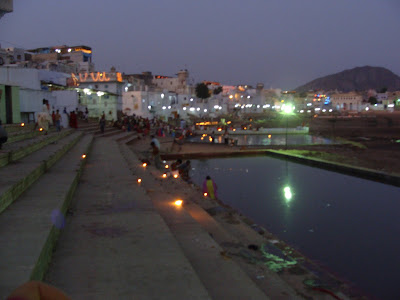









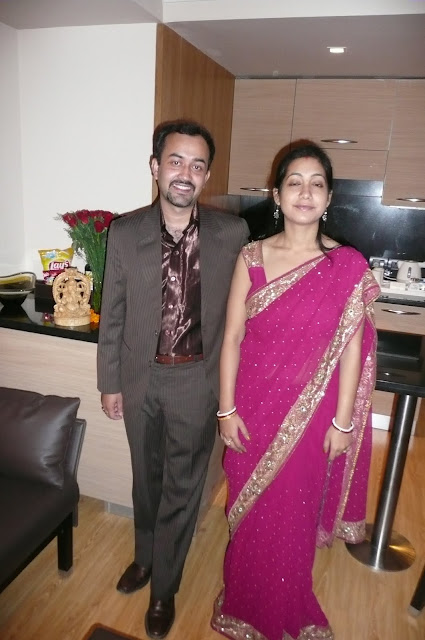





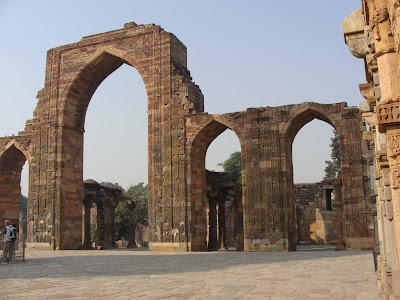


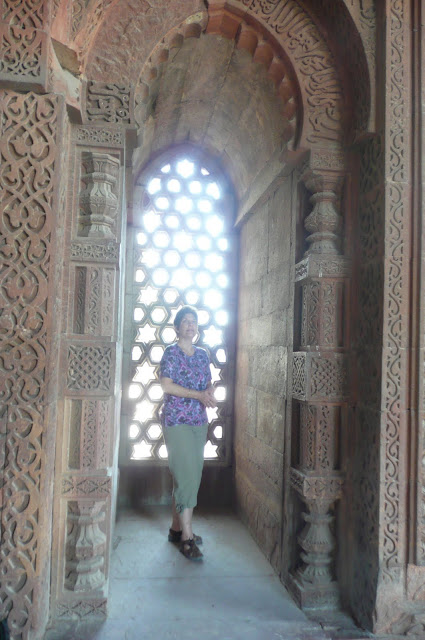
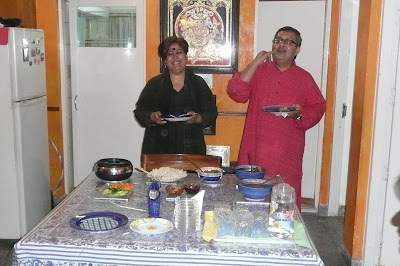
























2 comments:
Geez, is Staci taking notes as she walks around? I can't describe my own bathroom in as much detail as she's describing, well, everything! (I think my tub is some shade of beige, or possibly pink.) I was confused by her entry about "I looked down toward the other end of the bathing ghat..." until I realized she misspelled "goat". Now it makes sense. I hope you're having as much fun on your vacation as I am reading about your vacation. Keep it up!
That was amazing! I had to take a break half way through I was laughing so hard. You guys could do a weekly travel channel show just by Aunt Staci's journal and your side notes!!
Post a Comment